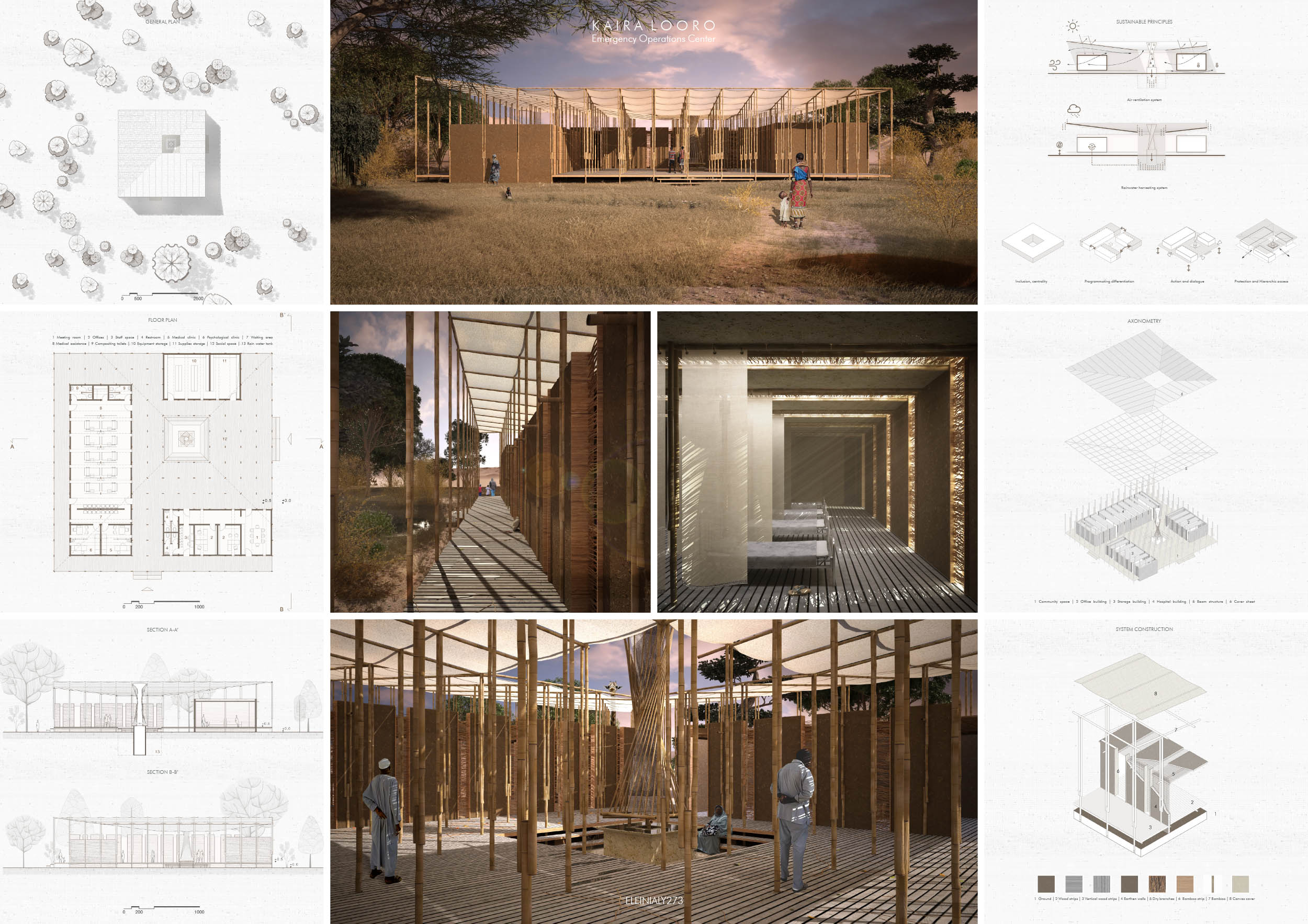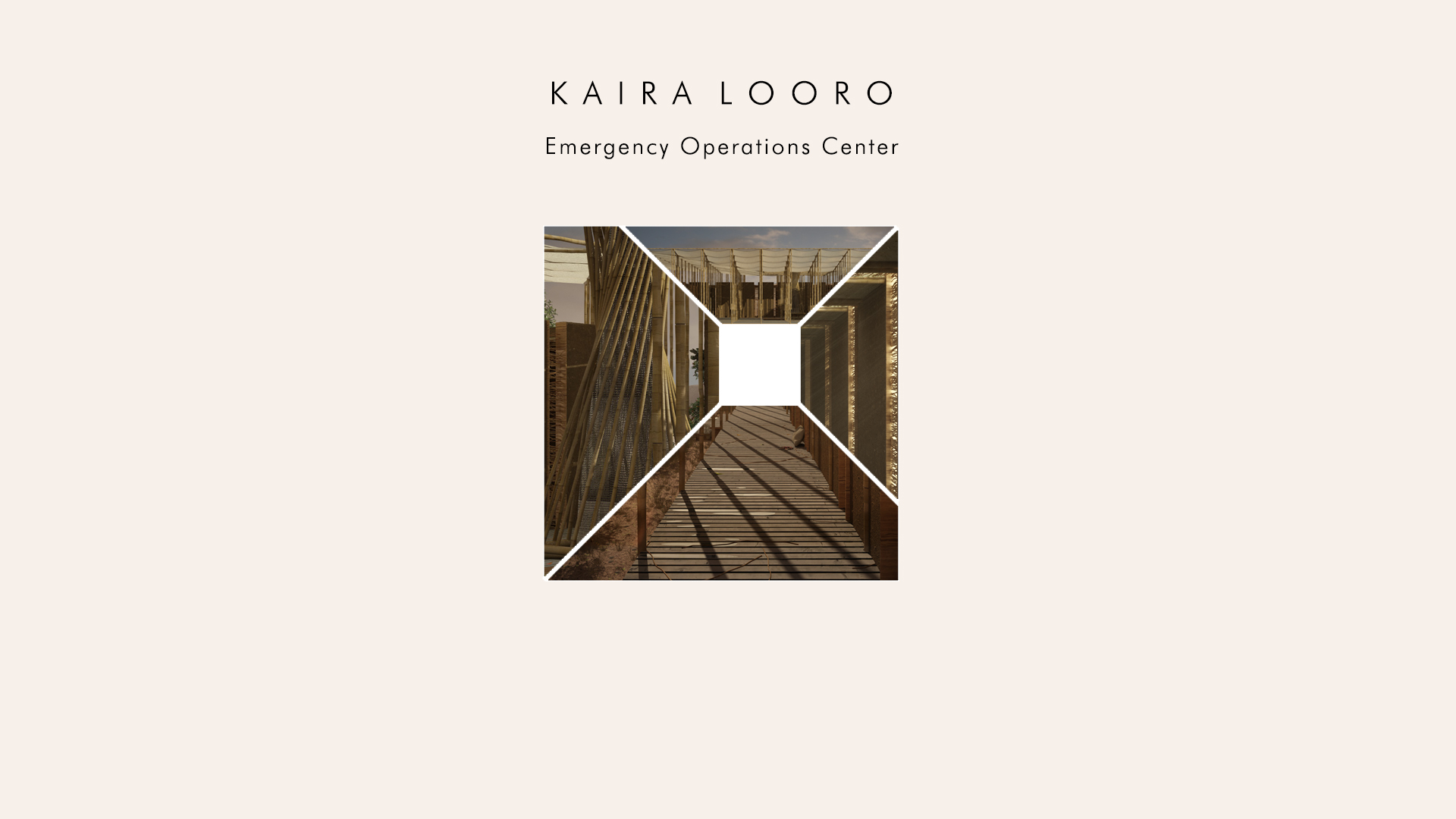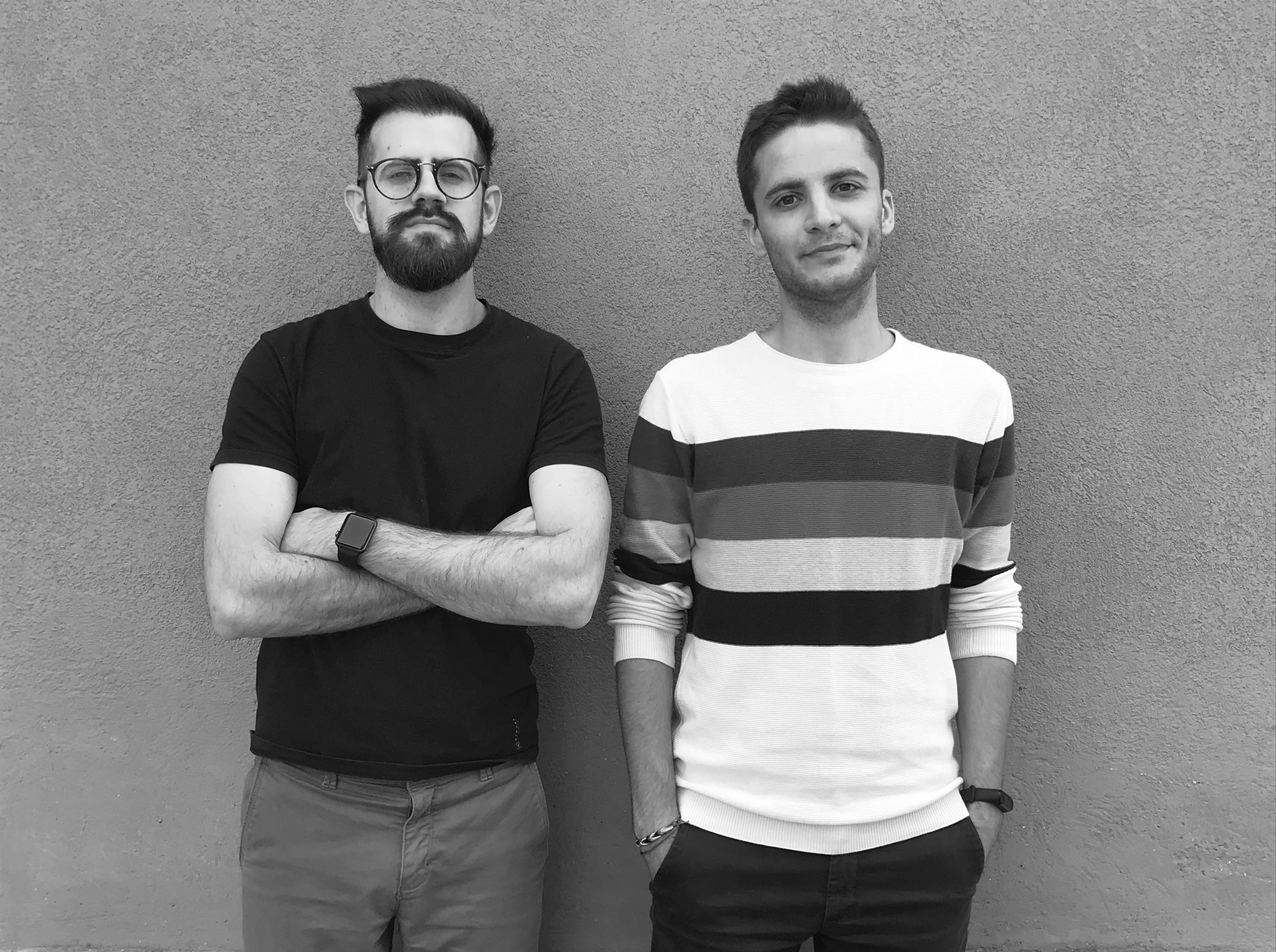3rd Prize
1st Prize - 2nd Prize - 3rd Prize - Honourable Mentions - Special Mentions - FinalistELEINIALY273
Project by: Michele Baldini, Marco Barzantifrom Italy


DESIGN IDEA
Nature and its elements may sometimes represent a danger, much more often they turn out to be in fact a source of salvation and reassurance, a clear example of this are the large trees that with their characteristic umbrella cover offer shelter and protection to those who take refuge under it. The evocative meaning of these concepts are the guide and the cornerstone of our design proposal, the intention is to create individuality of all these factors that is able to dialogue at the same time with the requirements of the project and with the habits of the population. The project provides for the definition of a spatial configuration that is as versatile and free as possible, a large dynamic space able to respond to the multiple requests that involves a building of this type. The supporting structure of the roof is formed by a forest of twin pillars of bamboo with a diameter of about 6 cm each arranged on a regular grid of 2x2 m. This system allows to create a totally independent structure, light and dynamic, whose modularity guarantees extreme versatility to the space. Similar to what happens in a beams-pillars structure, the roof is articulated and supported by a very regular bamboo texture arranged perpendicularly to each other in order to tighten up and connect the entire structure to the pillars. The roof is finally realized by using waterproof sheets disposed in a light downward direction, able to filter the solar radiation and spread the light evenly in the space below. The center is raised from the ground on a large common base, a platform of 780 sqm, elevated from the ground for about 50 cm. This allows circulation of the air below the floor, helping the cooling of it-self and of the ground during the hottest days. The elevation protects as well the building from the humidity, flooding and animals. The main area of this large covered porch is represented by the central impluvium, an open space where you can sit and rest. In case of rain, water is conveyed by the cover and through a process of purification and natural filtration stored in an underground tank. The gathering of water is also entrusted to the central structure that, thanks to its shape, wants to inspire the structure of large trees. The aim of this innovative tower is to capture the humidity by cross-ventilation and the temperature variation between day and night that condensate and collected in the central tank. Different structures build around the central patio which are covered by the same roof. The external space can provide double effects: connecting the internal center to the outside, which creates a first filter for the victim, but at the same time can be a social place that can rebuild the community. In fact, we believe that architecture must go beyond the simple concept of "shelter" and must be closely linked to the creation of identity and hope, especially in emergencies. The center for emergencies itself is therefore developed under the same coverage but in three different volumes for a total of 320 sqm. These spaces, diversified in size and height, are designed according to the concept that space starts from the “empty” to create the “full”. Building one of three, is used for management and handling of emergency (84 sqm): offices, meeting room and service room for the staff. The second, closes the opposite side of the court to accommodates the spaces dedicated to storage and logistics (60 sqm). This space is divided in two different environments to allow separation between materials/equipment and supplies useful for the operation of the center and activities in the field. The third is dedicated to the health and psychological care of the community (176 sqm), has two clinics for the medical and psychological assistance of users and a large flexible space dedicated to medical care and short-term medical monitoring of patients. This space can be easily reconfigured according to the requests and the type of emergency by accommodating beds for the support and medical care. There are also other spaces like toilets, a small depot and a waiting area. Given the temporary aspect of the structure and its services, toilets for the sanitary facilities has been designed of the type “composting toilets”, ideal for places with lacking water and without sewage system. The special structure of the roof, made of a single protective umbrella, allows us to play with volumes of the emergency center in a free and independent way. The building is in fact very dynamic with its visual permeability and continuous dialogue with surrounded nature. Façade vertical cuts scatter the volume, ensure the entry of diffused and filter light and grant an efficient ventilation able to maintain an adequate internal temperature.USE OF MATERIALS
The emergency center is designed to be entirely built with natural materials easy to find on site in order to minimize the environment impact. The bamboo, a construction material strongly present in sub-Saharan Africa, is used for vertical structures and for horizontal elements of the roof, fixed with dowels and jute rope. For the three volumes we foresee the use of the torchis technique. A duly woven grid is assembled and fixed to the supporting structure and a mixture made of raw earth, vegetable fibres and water is laid on it. These materials allow the development of assisted self-construction processes measured by the capacity and resources of a place. Mangrove branches or more simply waste and recovery materials found directly on the site like small diameter timbers can be used for the wooden trellis of the walls. Baobab wood slats are used for the floors and as jambs of the openings for its high resistance. Shading and waterproof cloth is used for the roof. The final demolition of the building does not cause any problems; the material can be quickly returned to nature and does not represent waste but can be a source of sustainability for the population.CONSTRUCTION PROCESS
The structure and its flexible construction system allow a variety of spatial configurations and activities. The construction process of the building starts right from the structure. As a first action, in fact, it is necessary to prepare the area on which to build the building with the necessary preventive actions and then start with the construction and laying of the bamboo pillars in the ground with the proper fixing system. The extremely regular and clear mesh of the pillars allows a subsequent and easy arrangement of the three rows of bamboo beams, fixing and framing them with dowels and jute rope at the appropriate height in the pillars. To complete the structure, we continue with the arrangement of the covering beams with the relative fixings and the final laying of the covering curtain. It is necessary to continue with the installation of wooden trellis useful for creating the walls of the building and the subsequent closure with the torchis technique. To complete the building, the flooring made of baobab wood slats is laid on the first order of beams. It is then necessary to finish with the installation of other wooden slats to mark the openings.INTERVIEW TO THE TEAM
by:Michele Baldini, Marco Barzanti from Italy
1) Can you tell us more about your team?
We are old university friends and colleague in a architectural firm in Italy. It was the first competition for us. During our bachelor’s studies we work in different group, developing different taste and kind of design.
2) What was your feeling when you knew you were among the top projects of the competition?
We decided to participate in this competition to test ourselves and have a first extra-academic experience. We never thought we would be selected and even win the third prize. When we received the confirmation email of the result, we were incredulous and surprised, these feelings were immediately followed by happiness and enthusiasm. This award represents a huge achievement for us!
3) Can you briefly explain the concept of your project and which is the relationship between it and the emergency?
The project provides for the definition of a spatial configuration that is as versatile and free as possible, a large dynamic space able to respond to the multiple requests that involves a building of this type. The supporting structure of the roof is formed by a forest of twin pillars of bamboo with a diameter of about 6 cm each arranged on a regular grid of 2x2 m. This system allows to create a totally independent structure, light and dynamic, whose modularity guarantees extreme versatility to the space. Similar to what happens in a beams-pillars structure, the roof is articulated and supported by a very regular bamboo texture arranged perpendicularly to each other in order to tighten up and connect the entire structure to the pillars. The roof is finally realized by using waterproof sheets disposed in a light downward direction, able to filter the solar radiation and spread the light evenly in the space below.
4) Which aspects of a design do you focus more during designing?
One of the purposes of architecture, especially in an emergency context like this, is also to recreate and increase the sense of community and hope. In designing the emergency centre, we therefore tried to always have our main objectives clear: the speed of construction of the building structure and the continuous dialogue with the context and tradition.
5) How did the material choice affect your design?
The use of bamboo for the structure and the ground for the walls it was a point of reference for the success of our project. Design was affected by material because the relationship with nature it’s directly proportional with the material. In that process, both bamboo (or local wood) and earth, can be found in any place that needs emergency building.
6) Has your project been inspired by anything-in particular, by some project in developing countries or past projects of Kaira Looro?
This represents, as we said, our first competition experience for the design of a building; the context in which this has to be placed was apparently foreign and distant to us. This factor has led us to deepen the study and analysis of rural buildings in sub-Saharan Africa and traditional construction techniques. Our aim was to present a proposal as effective as it is closely linked to tradition. The large trees with their characteristic umbrella cover immediately hit our imagination, they offer protection by constituting a fundamental resource. The evocation of this image guided our project: to bring together the functions and spaces of the emergency centre under the same space.
7) How your idea of architecture can solve emergency in developing countries, and how the community concerned could perceive this architecture?
The community they must be find hope in architecture, as the “ark” has always been a symbol of rescue. Architecture must do the same. Our intention was to create a repeatable scene that conveyed the same meaning, protection.
8) From your point of view, what are the responsibilities of architects in dealing with complex issues such as emergencies or architectures in developing countries?
In our opinion, designing a building in emergency situations does not mean simply responding to needs or simple functional dictates. It is also necessary to respond to specific psychological and emotional needs in order to try to restore confidence and serenity in the affected population. Where possible, people should be involved in participation and involvement in construction processes. It is also necessary, by the architects, a careful study of local traditions in order not to risk falling into the error of presenting a project that, although functional, appears detached and extraneous from the context.
9) The aim of the competition was also to improve the research on the topics of sustainable architecture with natural and recycled materials. How do you feel that contemporary architecture is approaching these topics?
Architectural thinking is already lagging behind problems such as these. Our generation must change this trend, which will certainly help the environment. On the other hand, we must not abuse it, it must not completely condition our concepts and thoughts. A middle way will be perfect.
10) Your fee, such as all fees of the competition Kaira Looro, was devolved to the non profit organization Balouo Salo that helps people in disadvantage area of Senegal. How it has affected you approach to the competition?
We decided to participate in this competition from the outset with great interest, determination and conviction, attracted by the noble purpose of the initiative.
11) The aim of the competition is also to give professional opportunities to young architects with internship prize and visibility at international level, and we wish your team the best achievements for your career. How do you think you will be in next 10 years? According to you, can this award affect your future?
Michele: I hope so, but I must admit isn’t a good chance in Italy. My obsession is to work in a famous Asian architecture studio. in 10 years, I see myself there. Marco: It is very difficult to try to answer this question. I can say that I am really satisfied with the result we have achieved; we have believed a lot on this occasion and I hope it will open up many opportunities for both. It is difficult to imagine where I will be in ten years, I have just started my career path but I can say with absolute certainty that the internship at MMA Design Studio in Johannesburg will represent an experience of absolute wealth and, I hope, a springboard towards a future full of satisfactions and opportunities to grow professionally.